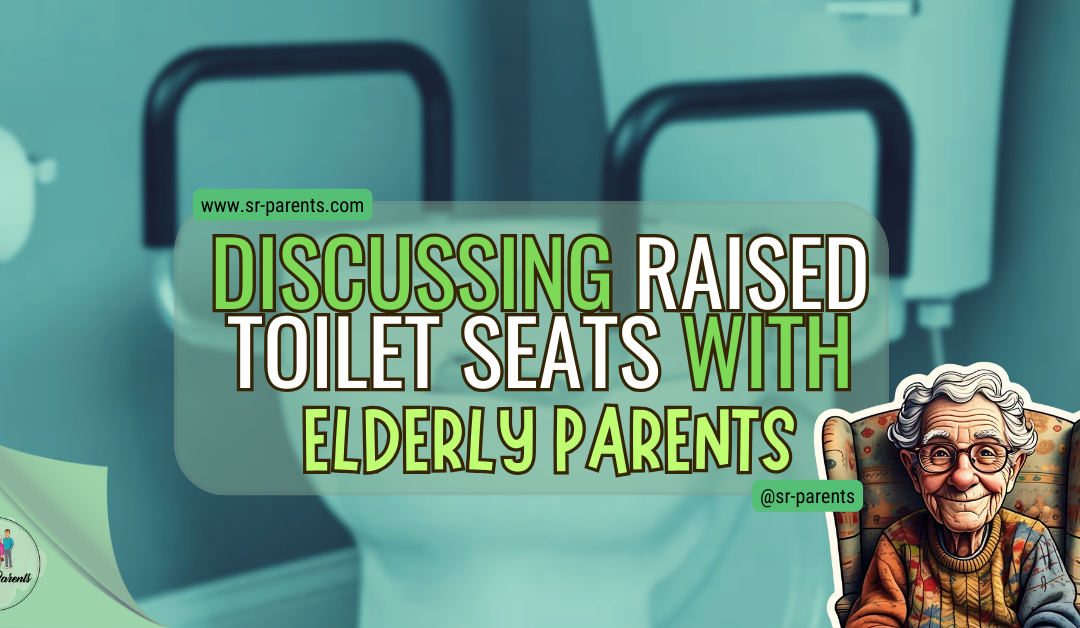Bringing up raised toilet seats with elderly parents can feel a bit awkward, but it’s a conversation I’ve learned is worth having. As our loved ones age, even simple tasks like using the bathroom can become more difficult and potentially unsafe. A raised toilet seat can make a world of difference, easing the strain on their knees and joints while giving them the support they need. When I approached this topic with care and genuine concern, I found it opened the door to a positive and productive discussion.
What helped me most was focusing on how these simple changes can improve their comfort and independence. I discovered there are so many options out there, from adjustable designs to ones that blend seamlessly into their bathroom setup. It’s about showing them that this isn’t about limitations—it’s about making life easier and safer. If this is something you’ve been thinking about bringing up, trust me, it’s a conversation worth starting.
Contents
Fostering Independence: The Importance of Raised Toilet Seats for Seniors
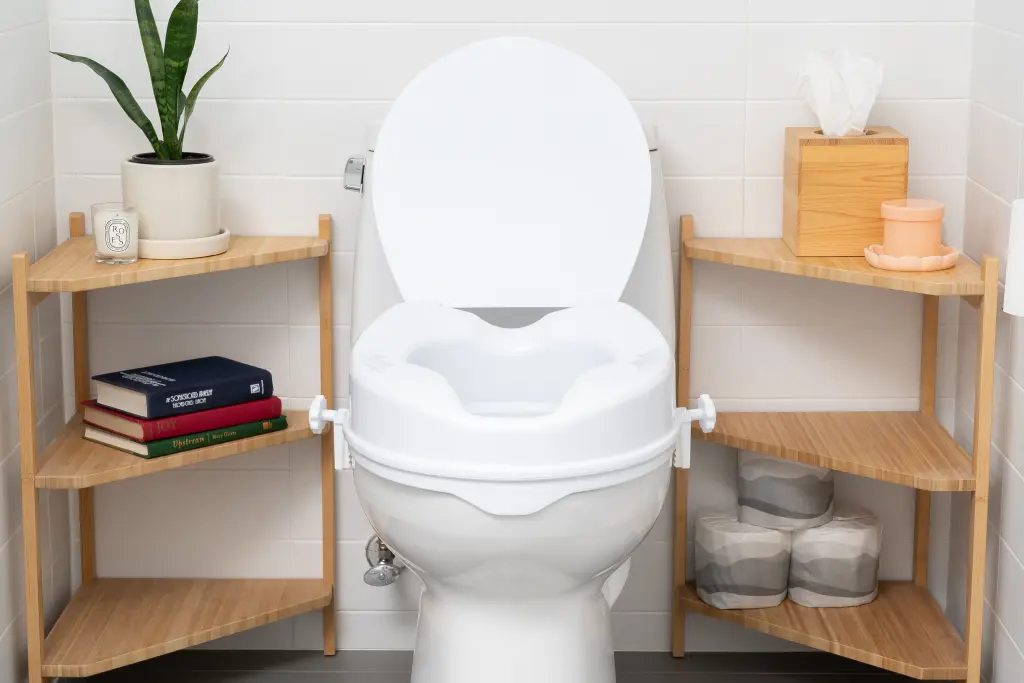
Discussing the introduction of raised toilet seats with an elderly parent can be a delicate matter. It often involves navigating both the physical need for assistance and the emotional reactions to the perception of lost independence.
Raised toilet seats are a practical solution for seniors experiencing difficulty with sitting down or standing up from a low toilet seat, providing them both safety and autonomy in the bathroom.
Addressing this topic requires sensitivity and a clear understanding of how these mobility aids can benefit the elderly. It’s important to approach the conversation empathetically, acknowledging the concerns and possible misconceptions surrounding their use.
By providing well-informed options and support, caregivers can assist their loved ones in making a comfortable transition to using raised toilet seats, thereby enhancing their overall quality of life.
Key Takeaways
- They make sitting and standing easier, reducing strain on joints and minimizing fall risks for seniors.
- Start the conversation in a private, comfortable setting, emphasizing how these aids improve independence and safety, not a loss of autonomy.
- Let them choose a style that fits their preferences and bathroom setup, ensuring it feels helpful rather than a burdensome addition.
- Raised toilet seats are not a sign of frailty; they are proactive tools that support autonomy and improve quality of life.
- After introducing a raised toilet seat, monitor their comfort and readiness for other aids and gradually introduce additional devices to support their safety and independence.
Understanding the Stigma Associated with Aging and Mobility Aids
It’s essential to acknowledge that stigma often surrounds the use of mobility aids among seniors. This stigma can manifest as a negative perception of aging and a reluctance to accept aids that signify older age and perceived dependency.
For many elderly individuals, the introduction of raised toilet seats may bring about feelings of embarrassment or loss of independence.
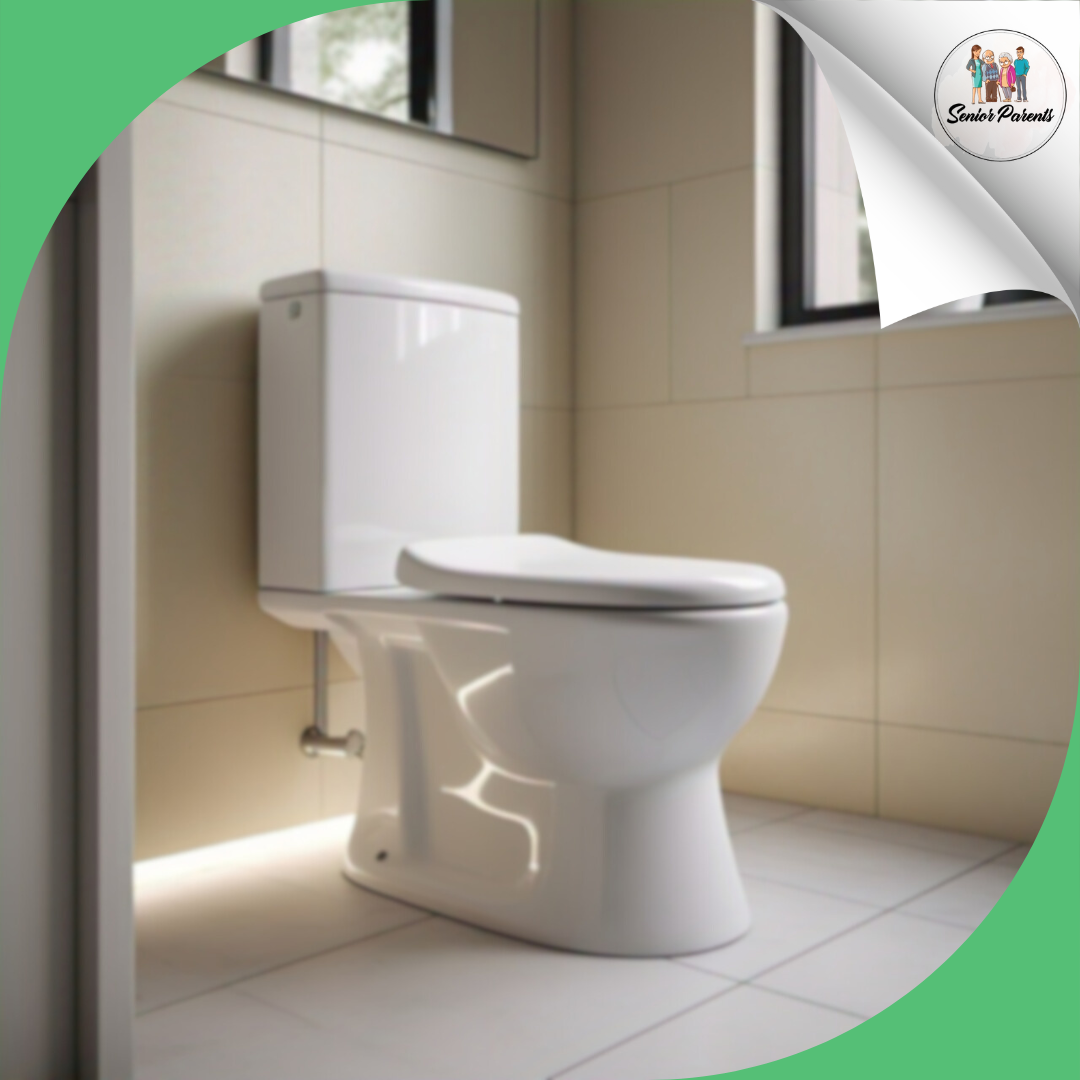
Key Points of Stigma
- Perceived Weakness: Seniors might view mobility aids as a sign of frailty, leading to a reluctance to adopt.
- Aesthetic Concerns: Concerns over the clinical appearance of aids like raised toilet seats may deter use.
- Social Judgments: There’s a fear of negative judgment from peers when using visible mobility aids.
Studies indicate that mobility aids can enhance confidence, reduce fall risk, and foster autonomy among seniors. However, apprehensions about being stigmatized often outweigh these benefits.
Even with varying prevalence across demographics, the hesitation to use such aids is a shared concern across different racial and ethnic groups. Family members must recognize and address these stigmatizing views.
By discussing the practical benefits and reframing the conversation around mobility aids – such as raised toilet seats – caregivers can help reduce the stigma.
Addressing these challenges openly and empathetically can pave the way for a more accepting attitude towards aids that support seniors in maintaining their independence and safety.
Check out this video about high toilet seats for the elderly.
By: Best Osmosis Experts | Home Improvement Tips
The Importance of Mobility Aids for Safety and Independence
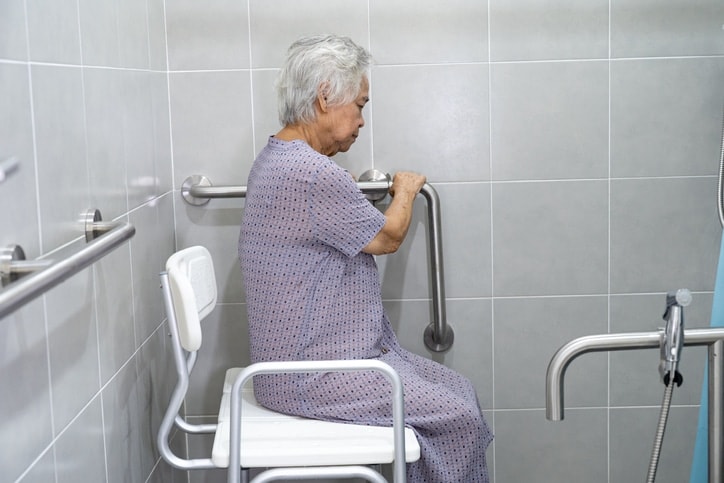
Mobility aids are crucial tools that provide seniors with increased safety and a means to maintain independence. They are designed to cater to the varied needs of elderly individuals and help them navigate their daily lives with confidence.
Preventing Falls and Accidents
Raised toilet seats are a prime example of how mobility aids can prevent falls and accidents. By increasing the height of the toilet, they reduce the effort and discomfort associated with sitting down and standing up, which are moments when elderly individuals are particularly at risk for falls.
Research supports that structured physical activity programs can help reduce the risk of major mobility disabilities in older adults by improving strength and balance. However, adding installations like raised toilet seats further minimizes the likelihood of incidents that can result in serious injuries.
Promoting Autonomy in Daily Activities
Mobility aids, such as raised toilet seats, not only enhance safety but also promote autonomy in daily activities. These aids empower the elderly to accomplish tasks, like using the bathroom independently, fostering a sense of independence.
For seniors, particularly those nearing retirement age, it is essential to have plans in place to manage personal health, as highlighted by resources like the CDC’s MyMobility Plan, which can help maintain mobility and independence at home.
Through thoughtfully selected mobility aids, elderly individuals can confidently and independently manage their personal care routines, preserving their dignity and quality of life.
How Raised Toilet Seats Can Benefit the Elderly
Raised toilet seats provide significant improvements to both comfort and safety for elderly individuals. These enhancements can make a notable difference in daily routines.
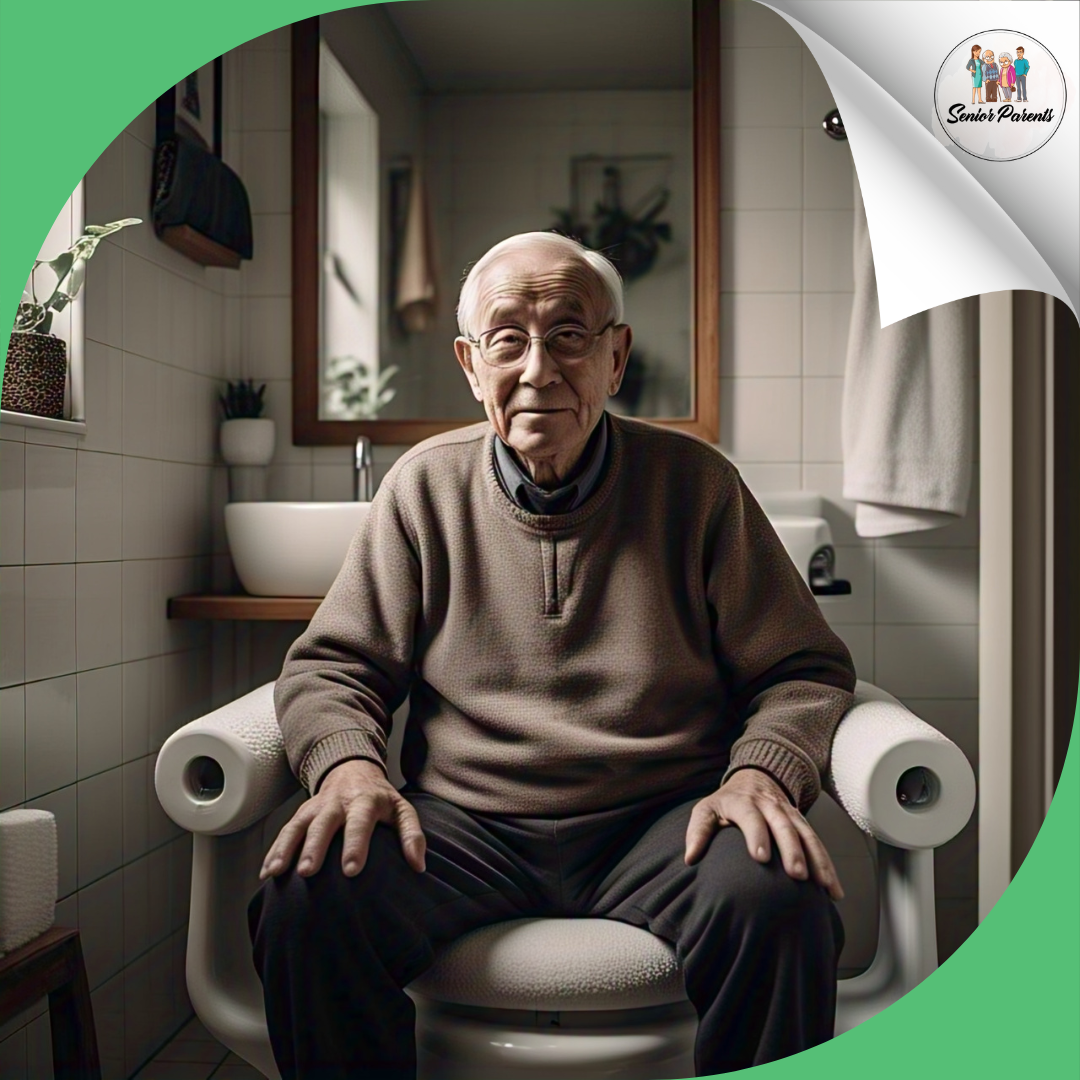
Ergonomic Advantages
Comfortable Height: A raised toilet seat can add up to 5 inches in height, reducing the distance one has to move to sit down or stand up. This adjustment can be especially beneficial for those with limited mobility or joint pain.
Support and Stability: Models like the RMS raised toilet seat comes with handles, offering additional support, which helps in maintaining balance and preventing falls.
Health and Hygiene Benefits
Reduced Joint Strain: The added height lessens the bend in the knees and hips, decreasing the risk of painful stress on these joints.
Ease of Cleaning: Some raised toilet seats are designed with hygiene in mind, facilitating easier cleaning to maintain a sanitary environment. For instance, the sturdy 2-inch Sammons raised toilet seat allows for simple cleaning routines.
Did You Know?
A raised toilet seat benefits individuals with mobility issues by reducing the distance they need to move when sitting down or standing up. This adjustment alleviates strain on the hips, knees, and lower back, making it easier and safer for them to use the toilet independently.
Initiating the Conversation with Sensitivity

Discussing sensitive topics with elderly parents requires tact and understanding. The right approach can make all the difference in how they receive the information and view adaptive aids like raised toilet seats.
Choosing the Right Time and Place
When starting this discussion, timing, and environment are crucial. Choose a moment when both parties are relaxed and can speak without interruption. This could be at home, during a quiet afternoon, or after a meal when a sense of comfort prevails.
An environment that is private and familiar can also provide a sense of security, making it easier for your parent to be receptive to the conversation.
Approaching the Topic with Empathy
Tailoring the conversation according to your parent’s feelings and experiences is of the essence. Begin by acknowledging the value of independence in their daily routine and gradually introduce the idea of a raised toilet seat as a means to maintain that autonomy.
It’s beneficial to use language that emphasizes support and care, avoiding any wording that may suggest dependency or infirmity. For example, phrases like “enhancing your comfort” or “simplifying your daily activities” can be more effective in conveying the positive aspects of using a raised toilet seat.
Addressing Concerns and Misconceptions
Many elderly individuals and their families may harbor concerns or misconceptions regarding using raised toilet seats. This section aims to confront these points directly, providing clear information to alleviate doubts and reinforce the benefits.
Dispelling Myths about Weakness or Disability
Raised toilet seats are often wrongly associated with losing strength or independence. However, it’s crucial to understand that using assistive devices like these is a proactive step, not a sign of decline.
- Myth: Raised toilet seats are only for the ‘frail.’
- Truth: They promote safety, reduce the risk of falls, and preserve energy.
Highlighting the Normalcy of Using Assistive Devices
The use of assistive technology, such as raised toilet seats, represents a standard approach to maintaining autonomy in daily living for people of all ages, including the elderly.
- Fact: Assistive devices are part of a universal design—tools meant to improve the lives of everyone, not just individuals with disabilities.
- Benefit: Regular use of such devices can sustain one’s standard of living and promote an independent lifestyle.
Selecting the Appropriate Raised Toilet Seat
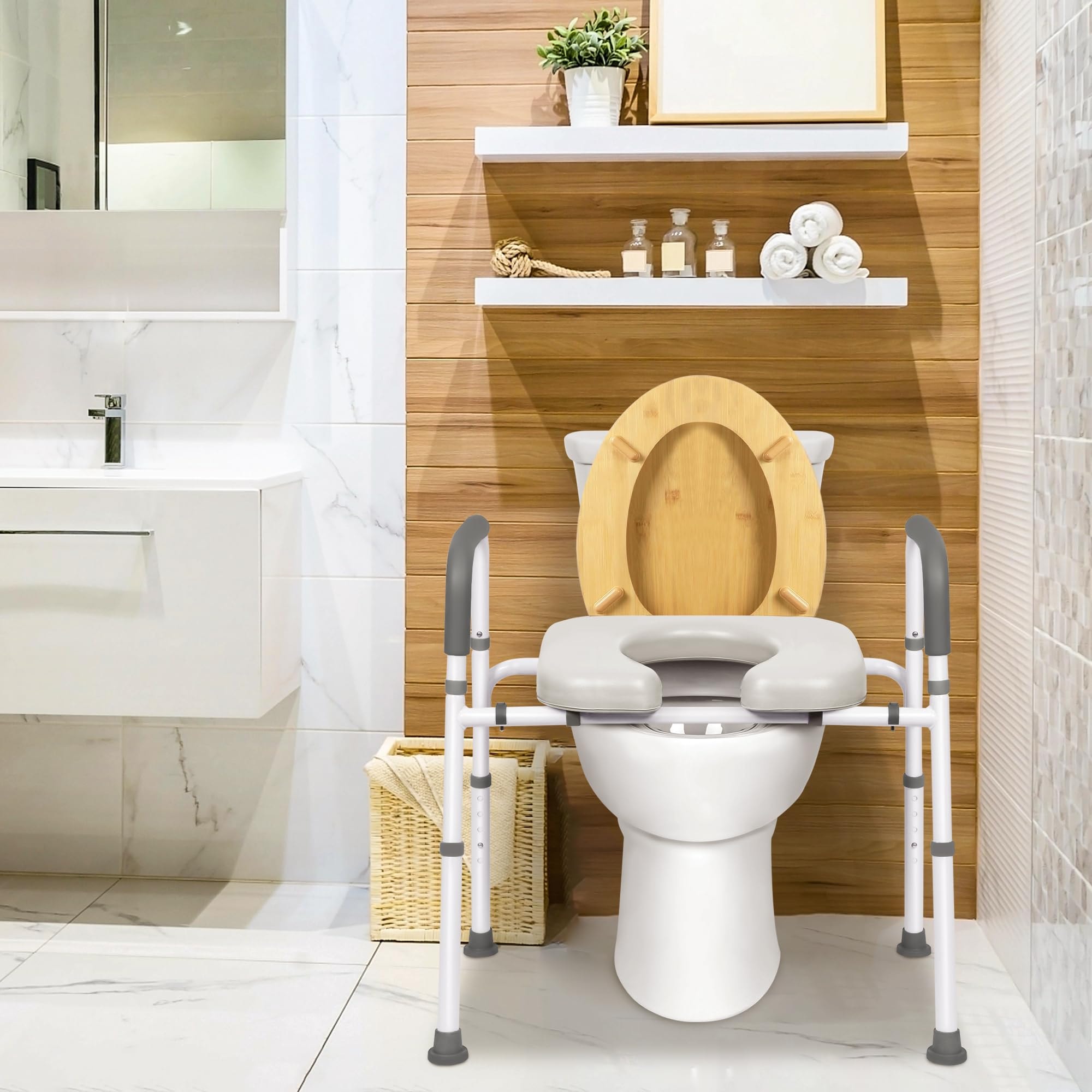
When choosing a raised toilet seat, one must prioritize features that ensure comfort, safety, and compatibility with the user’s physical needs and the existing bathroom setup.
Features to Consider
- Height Adjustment: Select a seat that provides the necessary elevation to make sitting down and standing up as effortless as possible.
- Stability: A raised toilet seat should be securely attachable to prevent any movement, offering a reliable and safe bathroom experience.
- Material: Durable materials that are easy to clean can maintain hygiene and last longer.
- Ease of Installation: Consider whether the raised toilet seat is easy to install or remove, as this can be crucial for users who may travel or have varying needs.
Matching the Seat to User Needs
- Body Compatibility: It’s important to ensure that the raised toilet seat fits the user’s body shape and size for maximum comfort.
- Toilet Bowl Shape: The seat must match the toilet bowl’s shape—be it round or oval—as a mismatch can compromise safety and comfort.
- User’s Height and Mobility: Factor in the user’s height and range of mobility to determine the appropriate height of the raised seat, thus aiding in promoting independence during use.
Installation and Maintenance of Raised Toilet Seats
Installation Steps:
- Remove the existing toilet seat by unscrewing the bolts.
- Align the raised toilet seat directly onto the toilet bowl.
- Place the original toilet seat above the raised seat if the design allows, making sure all screw holes line up.
- Insert and tighten the screws through the bolt holes, securing the device with washers and wing nuts if provided.
Maintenance Tips:
- Cleaning: Use a gentle, non-abrasive cleaner. Avoid harsh chemicals that could damage the seat’s surface.
- Inspection: Regularly check the stability of the raised toilet seat. Tighten any loose bolts to avoid slippage.
- Hygiene: For seats with padding or covers, ensure they are kept dry and clean to prevent the growth of bacteria.
Important Considerations:
- Weight Capacity: Ensure the raised toilet seat is appropriate for the user’s weight.
- Compatibility: Not all raised toilet seats fit every toilet. Verify that the product fits the shape and size of your toilet bowl.
- Features: Some seats may have additional features like handles, which provide extra support for getting on and off the toilet.
Providing Support and Encouragement

When discussing the use of raised toilet seats with an elderly parent, it’s crucial to approach the topic with sensitivity and understanding. They may feel apprehensive or self-conscious about needing help with such a personal aspect of their lives.
Create a Safe Space for Conversation
Start by ensuring the discussion takes place in a private and comfortable setting where your parent feels safe expressing concerns.
Acknowledge Their Feelings
It’s important to recognize and validate their emotions. For example, “I understand this change might be difficult for you, and that’s okay.”
Educate with Empathy
Share information about the benefits of raised toilet seats, such as:
- Enhanced Independence: Allows for more privacy and autonomy.
- Ease of Use: Makes it easier to sit down and stand up.
Discuss Options Together
Involve your parent in the decision-making process. Present different styles and features of raised toilet seats, and let them choose one that feels right for them.
Encourage Trial and Adaptation
Using a new aid can take time to get used to. Encourage a trial period where they can test the seat, and adjustments can be made as needed.
Provide Continuous Support
Ensure they know you’re there for ongoing support, and remind them that using a raised toilet seat is a proactive step towards their safety and comfort.
Transitioning to Other Assistive Devices If Needed
When an elderly parent begins using raised toilet seats, monitoring their needs for additional support is essential.
If mobility or balance continues to be a concern, discussing the introduction of other assistive devices becomes essential. Doing so can enhance their safety and maintain their independence.
Steps for Introducing New Devices
- Evaluate Needs: Assess daily activities where they experience difficulty.
- Research Options: Look for devices tailored to those specific needs.
- Consult a Professional: Seek advice from an occupational therapist for recommendations.
- Personalize Choices: Ensure the devices align with their lifestyle and preferences.
For example, if rising from a chair is challenging, consider a seat aid or lift chair.
Considerations When Selecting Devices
- Ease of Use: Devices should be intuitive for the user.
- Comfort: Prioritize ergonomics and personal comfort.
- Size and Fit: Ensure the device is appropriate for the user’s size and the space in the home.
- Safety Features: Non-slip grips and sturdy construction are key.
Begin with small changes and gradually move to more significant modifications if needed. Introducing one device at a time can prevent overwhelming them and allow adjustment to each new aid.
A Table of Potential Devices
| Activity | Device | Benefit |
|---|---|---|
| Walking | Cane or Walker | Provides stability |
| Bathing | Shower Chair | Prevents slips and falls |
| Dressing | Zipper Puller | Increases autonomy |
| Climbing Stairs | Stairlift | Reduces risk of falls |
Watch this video to learn how to choose the right raised toilet seat.
By: Drive DeVilbiss Healthcare
Why Discussing Raised Toilet Seats Can Improve Safety and Independence for Seniors
Discussing raised toilet seats with elderly parents isn’t always easy, but it’s one of those conversations that can make a real difference. When I first approached the topic, I felt unsure how it would be received, but I reminded myself of the importance of safety and comfort. By focusing on how these simple aids could support their independence and make daily life easier, I navigated the discussion with care and understanding. What surprised me most was how open the conversation became once I emphasized their well-being over perceived limitations.
I’ve learned that it’s about presenting the idea and involving them in the decision-making process. Whether choosing a design that blends seamlessly into their space or explaining how it can reduce strain on their joints, showing them the benefits made all the difference. If this is something you’ve been thinking about bringing up, trust me—it’s worth starting the conversation. You might be surprised at how much easier and more reassuring life becomes for everyone involved.
Frequently Asked Questions
Raised toilet seats are essential aids that provide ease and safety for elderly users dealing with mobility limitations. They help to minimize the strain on joints and muscles and can significantly reduce the risk of falls in the bathroom.
What Safety Considerations Should Be Taken Into Account When Installing a Raised Toilet Seat for the Elderly?
When installing a raised toilet seat for elderly users, ensure it is securely attached to the toilet to prevent slips or shifts. Some seats come with additional features like safety frames or handles, which provide extra stability for users as they sit down or stand up.
Are There Any Downsides to Using Toilet Seat Risers for Seniors?
While toilet seat risers are beneficial, one potential downside is that they can make it more difficult for seniors to clean themselves. Additionally, if not correctly installed, they can wobble, leading to discomfort or an increased risk of falls.
Can Insurance Programs Provide Coverage for the Cost of an Elevated Toilet Seat?
Some insurance programs, including Medicare, may cover the cost of an elevated toilet seat, especially if a healthcare provider prescribes it as a medically necessary piece of durable medical equipment.
What Features Should Be Looked for When Choosing a Toilet Seat With Handles for the Elderly?
When choosing a toilet seat with handles, look for features like adjustable height, padded arms for comfort, and the ability to support the user’s weight. Handles should also be securely fastened to assist with safe transfers on and off the seat.
What is the Recommended Toilet Seat Height to Accommodate Senior Users Effectively?
The recommended toilet seat height for senior users is typically between 21 to 23 inches from the floor. This height aligns with the average adult knee height to ensure comfort and ease of use.
Stay Engaged with Us
Are you ready to explore a journey of care and insight? Follow us on social media for uplifting content, expert guidance, and essential tips for supporting seniors!
? Website: Visit sr-parents.com for comprehensive articles and resources on senior health, wellness, and care.
? Pinterest: Find helpful caregiving advice, home solutions, and senior-friendly activities at pinterest.com/seniorparents.
? Facebook: Join our caring community at facebook.com/sr.parents. Connect with fellow caregivers, share experiences, and gain inspiration.
? Twitter: Follow us at twitter.com/senior_parents for the latest news, updates, and discussions on senior care.
? Instagram: Discover heartwarming moments, caregiving tips, and a glimpse into senior life at instagram.com/seniorparents.
Stay connected, motivated, and informed with our newest stories and expert articles on senior care.

